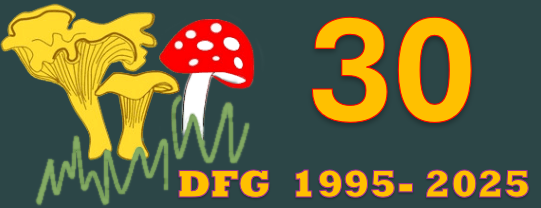Welcome to our new look site!
Spring Fungi (2)
Spring Fungi
M V Pike – DFG Foray Secretary
After what seems like an eternity in the fungi world, the “barren” winter months are now behind us and we can start looking forward to finding various species gradually appearing as the months pass by! With the last few topsy- turvy season’s it might also be worth keeping ones eye’s open for species not normally associated with this time of year, especially following any warm/damp spell we might have.
|
Springtime is not usually recognised as the prime time for fungi but it can produce a few nice surprises, the most common of these will be the St Georges Mushroom (Calocybe gambosa). This superb looking edible mushroom is quite a treat to find appearing around (as it English name would suggest) 23rd April. In reality though it can often be found earlier than this, indeed I have found it at the end of February in the past, but that really is exceptional! The mushroom itself is firm and robust with an all over creamy white colour, including the gills.
There are a couple of very obscure and rarely encountered Entoloma species around at this time, but It is difficult to confuse St Georges with anything else growing at this time of year, the main distinguishing feature is really its strong smell of fresh meal which is unmistakable. It is usually found growing in pastureland and gardens (often in fairy rings) and sometimes at the edge of woodlands, but rarely in them. I have found the Purbeck area to be a particularly good place to find them. As ever, it is always best to pick them young, as the older they get they tend to become very tough and unpalatable. They also have the happy attribute of almost never being plagued by maggots! St Georges lend themselves to most types of dishes or can just be eaten with good old bacon and eggs |
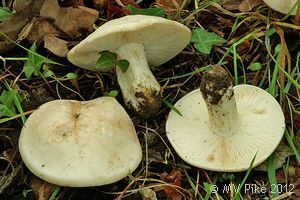 |
|||
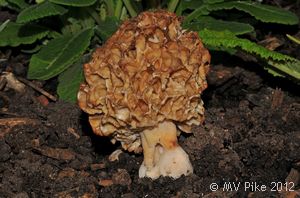 |
Another good edible species that can be encountered in the spring are the Morels, but unfortunately in my experience I have never found them to be common, quite the contrary in fact. It actually took me around 15 years of searching to find my first wild morel, and that was over the county boundary in Hampshire! Having said this Dorset and the Purbeck area have all the qualities and habitats for hosting them (underlying chalk, mixed woodland etc) so never say never! In recent years however some of the best places to look appear to be supermarket car-parks and gardens where the use of woodchip has burgeoned in recent years. Remember we are talking fungi here, so it is almost a given that a good edible such as this also has a lookalike that is inedible, and the Morel is no exception. The main impostor here is the False Morel (Gyromitra esculenta). Being of a similar size & shape and growing in roughly the same situations as the Morel it can be mistaken, but closer inspection of the cap reveals that it has a more lobed and rounded appearance than that of the true Morel which has a cap more like a honeycomb. Also called the Turban Fungus (because of the cap shape) it is certainly very dangerous as it contains a variety of nasty chemicals that attack the liver etc, one of these being the same type of substance used in rocket fuel! False Morels are fairly common in Purbeck but never plentiful and they are usually found in association with pine trees on sandy soils. |
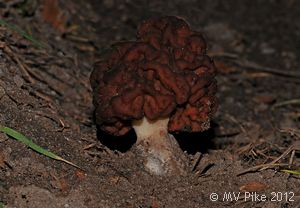 |
||
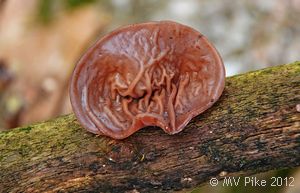 |
One more spring (sometimes all year) fungus that might be worth looking out for is the Jelly Ear (Auricularia auricula-judae). Looking remarkably like a human ear, this fungus is usually found growing on Elder trees, although very rarely on some other types. Picked fresh it has a very rubbery feel and texture to it, so if used for cooking it should really be dried and made into a seasoning powder. It would be extremely hard to confuse this fungus with anything else due to its shape! |
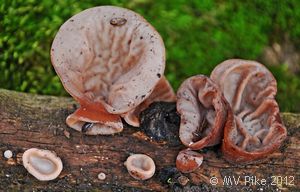 |
||
|
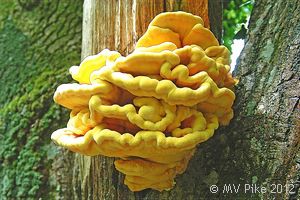
|
Early SummerLate spring into early summer can be an exciting time for the mushroom hunter, but often depending how the weather has fared during the winter and early spring period. An eye-catching fungus that can often catch you unaware, appearing as early as April is the delightful Chicken of The Woods (Laetoporous sulphureus). This vividly coloured sulphur yellow bracket (tree growing) fungus can sometimes be seen from some distance growing high up on ancient Oak trees (although not exclusively), tantalisingly out of reach of the average human being! To be of any use culinary wise this fungus must be used when at its young stage and never eaten raw; when old it dries out considerably and becomes very tough. It can disagree with some people so just try a small bit if tasting for the first time! It is quite similar to chicken in appearance and taste. Any found growing on Yew trees should be avoided due to these trees containing some poisonous substances. Some older specimens could possibly be mistaken for the Giant Polypore (Merupilus giganteus) but this usually grows from the roots of mature trees rather than higher up. |
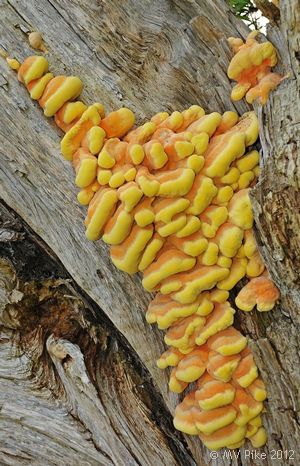 |
||
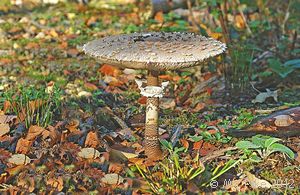 |
Another type that can often appear early on is the Parasol Mushroom (Macrolepiota procera). This is an incredible mushroom that can attain a huge size and can sometimes be seen in great numbers growing on unimproved grassland, fields and meadows and is common in Purbeck on Hartland Moor and Stoborough Heath. It does have a very tough stem however that should be discarded. In its fresh state it has a pleasant smell akin to warm milk and makes some very good fritters! Again, there is a lookalike which should be approached with caution. The Shaggy Parasol is very similar but the aforementioned tough stem differs in that it is smooth with no patterning, the Parasol has a snakeskin like effect all the way down it. The Parasol also differs in the fact that it does not bruise red/brown when damaged, a good identification feature of the Shaggy Parasol. Both species are edible but one must take care with the Shaggy Parasol as it has been known to cause stomach upsets in some people. |
|||
Reproduced with permission from PURBECK! Journal.
